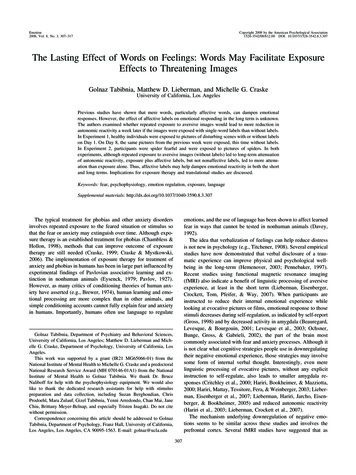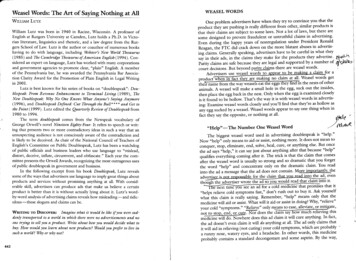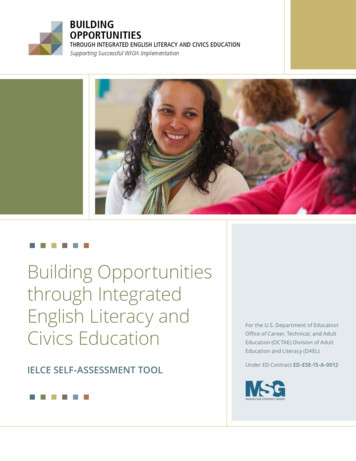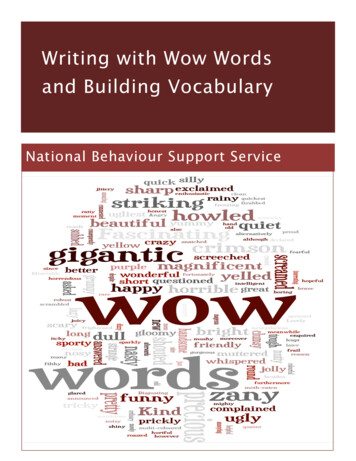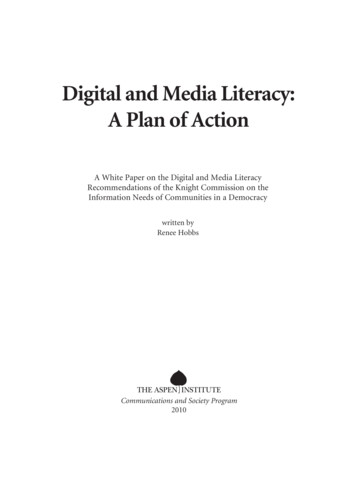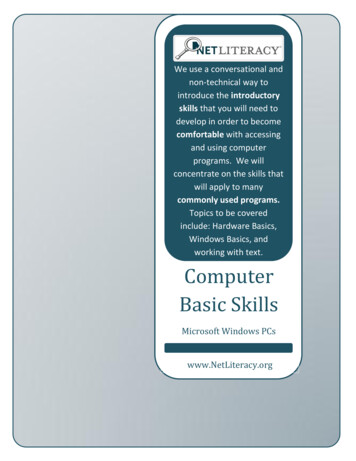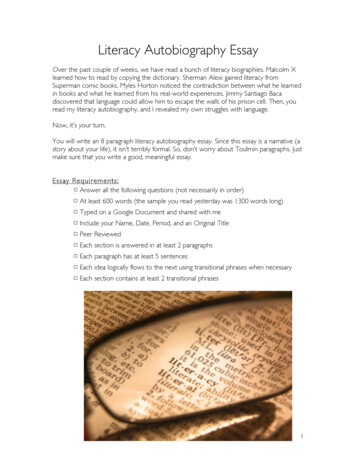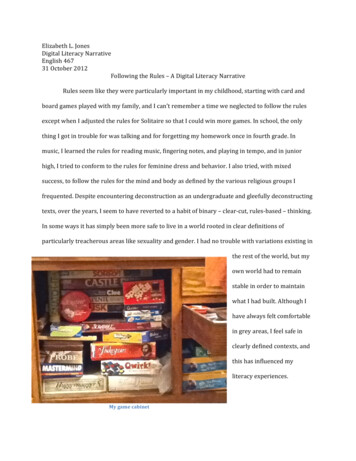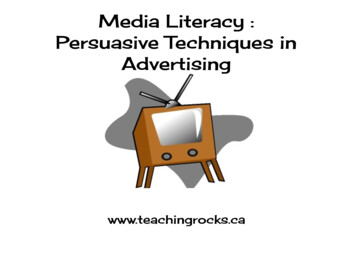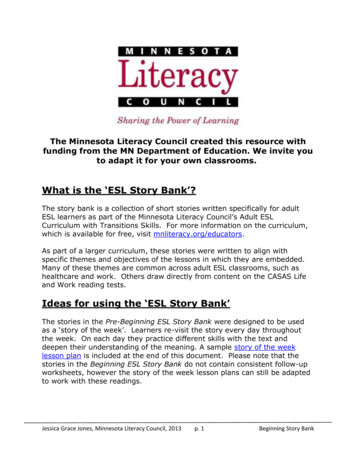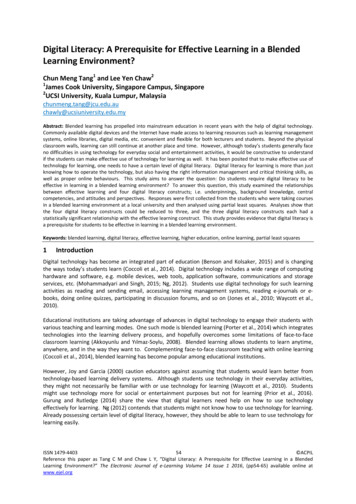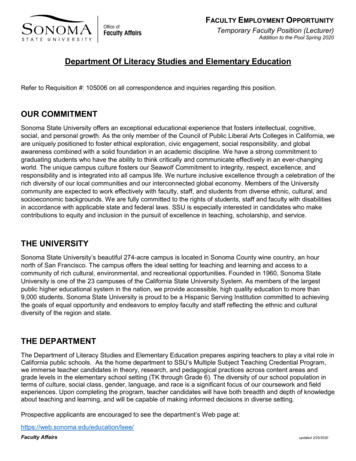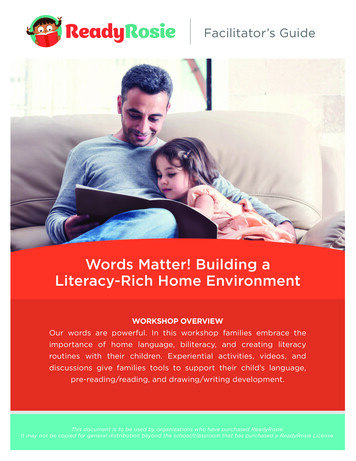
Transcription
Facilitator’s GuideWords Matter! Building aLiteracy-Rich Home EnvironmentWORKSHOP OVERVIEWOur words are powerful. In this workshop families embrace theimportance of home language, biliteracy, and creating literacyroutines with their children. Experiential activities, videos, anddiscussions give families tools to support their child’s language,pre-reading/reading, and drawing/writing development.This document is to be used by organizations who have purchased ReadyRosie.It may not be copied for general distribution beyond the school/classroom that has purchased a ReadyRosie License.
Family Workshop:Words Matter! Building a Literacy-Rich Home EnvironmentINTENDED TIMEFRAMEThis is a 1 hour workshop. This facilitator’s guide includes an optional 20 minute extension.LEARNING OUTCOMESParticipants will:»» Discover what a literacy-rich home environment is and why it is important for school andlife success.»» Practice learning activities that build a literacy-rich home.»» Use ReadyRosie to extend literacy learning at home as part of daily life.WORKSHOP FORMATNote: Each activity has a recommended video but other video options are provided sofacilitators can customize the workshop to meet the age/skill needs of participating families.1. Welcome and Warm-Up2. A Literacy-Rich Home Exploration3. Language and Communication Practice4. Literacy Skills Practice5. ReadyRosie as a Learning Tool Practice6. ClosureMATERIALS1. PowerPoint Presentation2.Materials»» Sign-in sheet»» Name tags for participants»» Flipchart paper»» Idea Catcher, paper, and pencils for participants to take notes»» High quality, diverse children’s books to practice read aloud skills(Minimum - one per table)»» Community resource handouts(Local Head Start to provide local community resource handouts you want familiesto know about.)»» EvaluationThis document is to be used by organizations who have purchased ReadyRosie. It may not be copiedfor general distribution beyond the school/classroom that has purchased a ReadyRosie License.
Welcome and Warm-Up15 minutesSlide 1ACTIVITYKEY POINTSWords Matter! Building a Literacy-Rich Home EnvironmentWelcome families and introduce yourself1. Introduce yourself and share why you are excited about facilitating the workshop.2. Take care of any housekeeping items, such as location of restrooms and announcements.3. Discuss the following:»» This is a safe place; we are all learning together. All discussions and things we share are confidential.»» This is a chance to build community, to connect and learn from each other.»» Please put your cell phones on vibrate.»» We are on workshop of the series. In our last workshop we discussed .How did your home practice go?Slide 2ACTIVITYPRACTICEDEBRIEF/REFLECTWarm-up Childhood Memory (5 Minutes)Take a moment to think of a favorite story, book, or song from your childhood. Who shared itwith you? Why did you love it?Pair and Share: Introduce yourself to someone at your table and share your memory.1. Ask: Does anyone want to share a memory or what you learned from your neighbor?2. Ask: How did your memory make you feel?SUMMARYRecap discussion by summarizing key points participants shared and then stating:1. Sharing stories, reading books, singing, and talking together are the building blocks of aliteracy-rich home in every culture.2. These activities build important literacy skills, family bonds, and memories.TRANSITIONSlide 3ACTIVITYIn today’s session we’ll be exploring these concepts in-depth.Workshop ObjectivesShare workshop objectives by stating that today we will:»» Explore what a literacy-rich home environment is and why it is important for school and life success.»» Practice learning activities that build language and literacy skills.»» Practice using ReadyRosie, so you know how to access fun literacy games at home.(Continue slide on next page)
Slide 3DEBRIEF/REFLECTWorkshop Objectives (continued)1. Ask: What do you already know about literacy?2. Ask: What would you like to learn about literacy and your child?SUMMARYRecap discussion by summarizing key points shared and writing down what participants want tolearn on a flipchart. Post the filpchart paper at the front of the room and refer back to it during theworkshop and at the end of the workshop as you cover the items they want to learn about.A Literacy-Rich Home Exploration15 minutesSlide 4-5ACTIVITYPRACTICEA Literacy-Rich HomeWe are going to take a few minutes to explore what we mean by a “literacy-rich home.”1. You are going to work with a partner to draw a quick picture of things you’d find in a literacy-rich home.2. This is not professional drawing. Use stick figures and rough sketches. It DOES NOT have to beanywhere near perfect.3. Create and show a really rough sketch on a flipchart or white board so participants see a simplemodel. This could be of a book or two stick figures with music notes in a speech bubble.4. Tell participants they have two minutes. Have fun. Go.5. Walk around the room to see what participants are talking about and drawing. Call time after two minutes.DEBRIEF/REFLECT1. Ask: What important literacy skill did you just participate in?2. Take one or two responses and then restate the answer: drawing. Share that drawing and scribblingbuild fine motor and pre-writing skills that children need to be able to write.3. Debrief drawing activity by asking participants to share a few things from their drawings.4. Acknowledge what participants mentioned and wrap-up by showingand reviewing any key elements that were missed.SUMMARYSlide 5A literacy-rich home is filled with:1. Eating together.2. Talking together.3. Storytelling and reminiscing/memory sharing.4. Singing.5. Looking at letters, words, signs, and print together.6. Playing with letters and words.7. Sharing books together.8. Scribbling, drawing, and writing together.9. Playing together.10. Doing chores together.11. Driving together.12. Going to the park.13. Running errands together.TRANSITIONWe are now going to practice a few important literacy skill builders you can do with your children.
Language and Communication Practice10 minutesSlide 6-7ACTIVITYWATCHPRACTICETalking Together PracticeWe are going to watch a ReadyRosie video. Watch closely and see what you think is being learnedin the video.Talking Together/hablandojuntos (or select a video from the list)Select an option for partners to practice the “Talking Together” activity.1. Option One: Use ReadyRosie Conversation Cards at the tables and have participants ask andanswer questions.2. Option Two: Have participants get into pairs and select 1-2 questions that you read from theReadyRosie Conversation Cards. Participants share answers with each other.3. Allow 2 minutes to discuss and share answers.DEBRIEF/REFLECT1. Ask: What do you think is being learned by families doing this activity?2. Ask: When could you see playing this “game” with your family?3. Accept all answers.SUMMARYSummarize any key areas not discussed:Slide 71. Rich vocabulary2. Creative thinking3. Conversation skills: taking turns, listening, and talking4. Self-awareness and expression5. Attending: making eye-contact, body language, nodding, reacting by smiling, etc.TRANSITIONWe are now going to focus on sharing books and storytelling together.Slide 8How do Books Work? (5 minutes)ACTIVITYThere are so many ways to enjoy books together. Watch this video and see what you think is being learned.Funny Reading (or select a video from the list)WATCHDEBRIEF/REFLECTAs a table, talk about what was being learned in the video.1. Ask: Why do you think playing with books this way is important?2. Accept all answers.3. Ask: Can we use some of the same ideas for storytelling? What if we start a story by saying, “theend and then the dragon ”?(Continue slide on next page)
Slide 8SUMMARYHow do Books Work? (continued)Summarize any key areas not discussed. Knowing how books work is an important pre-literacy skill.The video showed a family having fun, reinforcing:1. How books work: right side-up, front to back, and reading left to right.2. Parts of a book: front/back.3. Turning pages.4. Text vs. picture.5. Title.6. Letters and words.7. Author and illustrator.TRANSITIONLet’s talk about some other ways we can enjoy books together.Literacy Skills Practice10 minutesSlide 9ACTIVITYWATCHPRACTICEDEBRIEF/REFLECTBook and Story Conversations (Think about the questions youwould ask before reading, while reading, and after reading.) (5 minutes)Think back to the memories we shared at the start of the workshop. We talked about the importanceof storytelling and sharing books. We are going to take a few minutes to practice ways to enjoystories and books together.We are going to watch a Ready Rosie Video, Preview and Predict. Watch video up to 1:04 seconds.There is a children’s book at your table. Look at the book and talk as a group about what questionsyou would ask your child before reading, while reading, and after reading.1. Ask: Why is it important to talk and ask questions when you are sharing books and stories?2. Take all answers.3. Ask: Can we use some of the same ideas for storytelling? Answer: Yes, stop in the middle of a storyand ask, “what do you think is going to happen next ?”SUMMARYSummarize the points made and wrap-up by stating that it is important to talk about books andstories with your children. It’s good to ask questions:»» Before you start reading (like you saw in the video).»» While you are reading.»» After you are finished reading.»» Talking about books and sharing stories is important. It opens the world to your children.It builds vocabulary, pre-reading skills, bonding, knowledge, visual literacy, comprehensionlistening skills, and participation in the story.
Slide 10ACTIVITYPRACTICEStorytelling/Reading RoutineLet’s talk about how we can build a storytelling/reading routine at home.1. Ask: How many of you read or tell stories with your children daily? Ask for a show of hands.2. Ask: How many of you have a library card? Ask for a show of hands.DEBRIEF/REFLECT1. Ask: What gets in the way of telling stories and sharing books daily?2. Accept all answers.3. Debrief: Summarize the barriers families share and ideas for overcoming them. Make sure you discusshow to get access to books. Encourage going to the public library and getting a library card, talking toyour classroom teacher and borrowing books, going to garage and library sales to get used books.4. Reflect: Ask participants to think about what they are willing to try this week to start orcontinue a reading/storytelling routine.5. Ask: Participants to share a few of their ideas.6. Reinforce that storytelling and reminiscing is always free and available anywhere, anytime.SUMMARYRecap key points participants shared and then summarize key things to build a daily storytelling andbook sharing routine at home:1. Find a special time for it each day (it can be on the go).2. Get comfortable.3. Make it fun.4. Find good books (the library) and things that inspire you to tell stories (memories, props, wordless books).TRANSITIONSlide 11-17ACTIVITYPRACTICEDEBRIEF/REFLECTWe are going to talk about one last important piece in our literacy-rich home.Drawing and Writing TogetherDrawing and writing are a way of communicating with one another with signs and symbols. Learningthose symbols and how to form them are complicated skills and require lots of practice. We aregoing to have fun experiencing just how much work this is for our children.I want you to pick up a pencil on the table. Now switch hands (put it in your non-dominant hand),and I want you to write your name on a piece of paper.1. Ask: How did that feel? Imagine how much work it takes our children to learn to write. We wouldneed to strengthen the fine motor muscles in our non-dominant hand, to be able to draw andwrite well with it.2. Ask: What can you do to help your child build fine motor muscles? Have a few participants sharetheir answers.3. Reflect: It is important to give your children lots of opportunities to build fine motor skills. Many ofthese things are a natural part of daily life: eating, buttoning, zipping, picking things up, grasping,cutting things with children’s scissors, holding cards, scribbling, drawing, stirring, etc.4. Drawing and writing are developmental processes that takes time.Let’s look at the stages of writing.Slide 12-175. Ask: Share how your family includes writing and drawing in your family routine as a fun means ofcommunicating with one another or with family and friends?Reflect: Listen to class answers. Share the following ideas if they not mentioned by the class: thankyou pictures/notes, letters to Santa, tooth fairy/el raton, etc., “I love you” notes on a napkin inlunchbox or on a sticky note on a pillow, writing name on personal items, etc.
Slide 11-17SUMMARYDrawing and Writing Together (continued)1. Drawing/Writing is a complicated skill. It takes hand and finger strength (fine motor skills), eye-handcoordination, being able to use two hands, visual perception (being able to make sense of visualimages, symbolic comprehension ).2. Your role is to give your children lots of opportunities to draw and write and make it as enjoyableand fun as possible.ReadyRosie as a Learning Tool Practice7 minutesSlide 18ACTIVITYPRACTICEReadyRosie Practice (7 minutes)We are going to spend 5 minutes navigating the ReadyRosie app, so you know how to find content.We are going to start by finding some great writing activity ideas. We can search for content on theReadyRosie App or Website.1. Open the ReadyRosie App and login. If your families are not using the RR app you will need to allowextra time for them to download the app and login. Or, you can assign this as their home practice toaccomplish prior to the next workshop and show them how to do a search on using the ReadyRosiewebsite.2. Search for “writing together.”3. Look for an activity that targets your child’s age.4. Spend the next 3 minutes looking for a writing activity you are excited about trying.DEBRIEF/REFLECTAsk: What other topic(s) are you interested in finding for activities to do together?Point back to the items the class said they wanted to learn about at the beginning of the literacyworkshop. Encourage them to use the app to continue learning outside of the workshop.SUMMARYYou have access to the complete ReadyRosie library; so in addition to the weekly videos you receive,you can also look for specific content anytime.Closure8 minutesSlide 19DEBRIEF/REFLECTWrap-up (8 minutes)1. Remind families of the home practice and commitments you want them to focus on this week:»» A reading routine»» Playing the games they practiced during the workshop»» Playing the game they found during the ReadyRosie practice activity»» Encourage families to share the memory they talked about at the beginning of the workshopwith their children2. Share local community resources you want families to know about.3. Remind participants about the next workshop in the series.4. Have families complete the workshop survey before leaving class.
Extension: Storytelling and Reminiscing20 minutesSlide 20ACTIVITYWATCHPRACTICEDEBRIEF/REFLECTStorytelling and ReminiscingKnowing your family stories builds confidence and self-awareness in your children. Storytelling is afundamental way that children begin to form their identities.Watch the Storytelling Story Train video.Have each table create a story by playing the story train game.Select at least one question and have a group or table discussion:»» How did it go?»» What is being learning?»» Do you think it will get easier with practice?»» Would your children enjoy playing this game with you?PRACTICEDEBRIEF/REFLECTThink of a childhood memory you would like to share with your child. What is it about? Who is partof the memory? What is happening? What senses come to mind when you think of this memory?1. Take turns sharing your memory with a partner at your table. Allow a few minutes for sharing.Make sure each partner gets an opportunity to share a memory.2. Ask: Do you share memories with your children?3. Ask: Why is this important?SUMMARY1. Storytelling or reminiscing may feel awkward initially, but it gets easier the more you do it. Yourchildren will love the attention. It is free and can be done anywhere and anytime.2. The stories you create together can then be labeled, dictated, or drawn.3. If you can tell a story, you will ultimately be able to write a story.4. When stories and memories are told to children in detailed and responsive ways, they buildvocabulary, empathy, knowledge of what makes a good story, and the ability children need to telltheir own stories.5. Research shows that teenagers who have a strong sense of family history are better able to copewith teen stressors and feel more connected to their families.HOME PRACTICEYour home practice is to play the storytelling round robin game and take time this week to shareyour memory with your children.
ReadyRosie SHARE and Video AddendumThe power of ReadyRosie is the ongoing follow up and support available digitally for families. Use SHARE tocommunicate with families and support their ongoing learning by sharing the videos that were covered in therecent workshop and any additional videos in this domain you think they will find inspirational. This messagecan also be sent to all the families who were unable to attend the workshop.Sample message:“Our recent family workshop focused on literacy-rich activities you can do at home with your children.Here are the videos we recommend you enjoy this week as part of your home learning.”DomainVIDEOS highlighted in theReadyRosie Literacy FamilyWorkshop:Additional videos toshare in this domain:BABY: Listening for SoundsPRE-K: I’m Thinking of an AnimalTalking Together andLanguage DevelopmentKINDERGARTEN – 1ST: Bag of Rhymes2ND – 3RD: Noun CharadesBABY: Book ChatsPRE-K: Reading the Grocery ListShared ReadingKINDERGARTEN – 1ST: Picture Walk Predictions2ND – 3RD: Read A Little Think A LittleBABY: Color with MeWriting TogetherActivity(no videos)PRE-K: Writing Names with Shaving CreamKINDERGARTEN – 1ST: Simon Says Draw2ND – 3RD: Sketching the StoryBABY: Tell Me a StoryStorytellingPRE-K: Retelling the StoryKINDERGARTEN – 1ST: Storybook Storytelling2ND – 3RD: The Story of Your Name
We are going to take a few minutes to explore what we mean by a “literacy-rich home.” 1. You are going to work with a partner to draw a quick picture of things you’d find in a literacy-rich home. 2. This is not professional drawing. Use stick figures and rough s
